My Gangabal Travelogue-2014
It was probably August or September 1989..I along with my friend had gone to Gulab bagh, to meet his relatives. Their house was situated just below the Mountain. My friends cousin-who at that time was working with JK Police-was a raconteur. He narrated his experiences of the journeys up in the mountains and I was glued to his narration and eloquence of story-telling. It was at that time, from him, when I first heard of Gangabal.
He told us about the mythical-creature-Krim, that lives in the Lake called Gangabal. “Krim pulls down any man who attempts to swim in the lake and then eats them alive”, he gesticulated and his tone reflecting sincerity. When he was speaking about the “Krim”, a picture of a water creature such as an Octopus or a squid came in front of my eyes. “Where is Gangabal?”, I asked him out of curiosity. He pointed his finger towards the Mountain situated just above his house and replied, “Beyond these Mountains”. At that very moment, I had made up my mind to visit Gangabal next year in 1990.
But 1990 had its own plan. It took me another 24 years before I could realize my dream. Thanks to team APMCC for doing a yeoman’s job by organizing the Yatra after a gap of more than 100 years.
I landed in Srinagar Airport on 31st August along with my friend Manish Zijoo. It was a bright sunny day. My friend Ravinder Koul was already there waiting for us. He drove us to Zeethyear Shrine. Vinod Pandit of APMCC had organized the stay of yatris for the night at the Dharamsala in Zeathyaer.
Next day, on sep.1, amidst heavy rains, 95 pilgrims, including I and my 3 friends started our journey from the shrine. We were supposed to leave by 7.00 a.m, but rains played a spoilsport, and we got delayed by 2 hours. APMCC/HGT had arranged two buses for transporting the pilgrims from Srinagar to Naranag-the base camp. The weather had cleared up by the time we reached Naranaag. The Indian Army Battalion, Rashtriya Rifles, had organized the breakfast for all the pilgrims. After having the breakfast, and the ceremonial pooja, our ascend towards Gangabal Started. The option of ascending by a horse/ pony-ride was also available. All the Horsemen and Ponywallas are the indigenous Muslim-Gurjars. They were charging 900 rupees/person.
Vinod Pandit had in fact advised us to hire a horse/pony up to the Lake as the climb was very steep. We hired two horses for the journey for two of my friends . The starting climb-known as Buthsher- was indeed very steep. After a few hundred meters of climb, I looked down towards the valley below. A lone cloud was running through the valley below as if in a hurry to meet its beloved, A stream ran through the cleavage of the lush green valley below, Its zig-zag course getting lost out of sight somewhere in between the tortuous valley below. The ruins of the Narannag temple was no longer visible. The imprint of the hooves of the horses on the soil kept on changing, so did the staccato made by the hooves striking the rocks.
I had decided to ascend the journey by foot. My friends who had started the journey with me were left behind somewhere. For most of the time during the ascend, Manish and Ashok kumar koulji remained with me as my companions. While Manish and I were going for the first time, It was second consecutive trip for Ashokji. “Mahra, when will this steep climb end? When will we reach the pinnacle?”, we pestered Ashokji, many a times. “We are almost there”, he would assure us each time.
The steep climb-Buthsher-is an strenuous 4 hour jouney. The path is dotted by the tall Deodar tress. The winding rocky path occasionally threw open the beautiful vistas, worth to be captured by the memory. En-route, a vast stretch of Burnt Deodar was intriguing. The nip in the air had increased and many pilgrims opted to wear extra woolens.
The climb ended at the only refreshment-point cum Dhaba- “Hotel Khedmat”. At this point, we ate the yellow-rice known as “Tehar”. This Tehar was provided to us by the organizers of the journey at the Zeethyaer shrine. After that, most of the pilgrims sipped the hot tea at the Dhaba. After a few hundred meters ahead of the Dhaba, the mist engulfed us, and the chill factor intensified.
The journey from the Dhaba to Gangbal Lake is rather gentle as compared to Buthsher . After an hour or so, a lush meadow revealed itself to us. This meadow also serves as a camp to Rashtriya Rifles. In their traditional hospitable style, they offered the pilgrim snacks and tea. After an hour or so, as we were reaching close to our destination Gangabal, another lake-Nundkul passed by us.
I reached the camp at around 7.30 p.m. I checked-in a camp along with Manish. I was shivering with cold. By 8.30 PM, most of the yatris had reached the camp except two groups-Who reached the camp by 11.30 p.m. At 9 p.m or so we had our dinner and immediately, we nestled under the thick Quilt to keep us warm .In our tent, There were total six quilts and six mattresses for six persons. The tent where I stayed put for two nights was shared by my three KP friends and two Non-KP’s from Ghaziabad. we all bonded well during our stay at Gangbal.
In the late evening, I could hear the sound of Rain. The cold was so intense, that we all opted to combine two mattresses and two quilts per two persons. One mattress was layered above the other and one quilt layered above another quilt. We snuggled under the thick quilts, thus getting some respite from the Cold and all slept like a baby.
Next day , 2nd September,I woke up at 6 a.m, I opened the zip of my tent and peeped outside. The mighty redoubtable Harmukh was standing in front of me.I decided to have a clear look and came out of my tent, hanging a DSLR in my neck. The Harmukh mountain was besieged by a thick blanket of perennial Glacier . A sight to behold.
As I was watching the Mountain, I could not forget that, It was probably, during the reign of Mir Shamas-ud-din iraqi, when, in 1519 AD,10,000 KP’s were killed during pilgrimage to Harmukh Ganga as they had gone there to immerse the ashes of 800 Kashmiri Pandits, who were massacred during Ashura, a year ago.
I ambled towards the lake. The sun had not yet risen. The first looks of the turquoise waters mesmerized me. Nestled in between Mountains, Its aura was reflecting beauty par excellence. Once I reached close, I could see the limpid waters. The pebbles at the base of the lake were quite visible. And the waters quite-Icy!
Before coming to Gangabal, I had read a bit about the lake. It was written in an article, that KP’s used to come here and do the Obligatory “Shraddh”(prayers offered to ancestors) and immerse the ashes of those who had died. Before, immersing the ashes into the lake, they used to stock the water for drinking and cooking, as immediately after immersing the ashes, the colour of the waters would change to Red, (because of some micro-organisms), thus making the waters unfit to drink or cook food in.
At around 9.00 a.m, in the freezing cold, I along with my friends Vishal, Ravi, Manish and Ashokji had a dip in the icy-cold waters of the Gangabal. A group of pilgrims later on performed the “Sharadh” of their ancestors by the bank of the Holy Lake. I meandered around the camp site and climbed down a bit to have a close look of the lake “Nand-kul”. A rivulet joins the Lake Gangabal,-which is some feet higher- to Lake Nand-kul. Both the lakes are situated at the base of the Harmukh-Mountain.
The lake is situated at around 13000 feet above sea level, thus making even an easy activity like walking somewhat difficult. It was raining intermittently from morning till afternoon. After our lunch, the rains felt incessantly till we left the Kashmir valley. Mind you, It was at that time when Kashmir valley faced its worst floods in recent times.
With the advent of the incessant rains, the activity of all the pilgrims was limited to their tents. I and my tent-mates spent most of our time discussing a wide spectrum of topics from religion to politics to caste system, Kashmir, History etc. Occasionally, one among my companions would narrate a joke and the rest would Guffaw, thus making us forget about the Rains outside.
.
The intensity of the rains ebbed somewhere in the evening-when we got some time to click Group photos-The short respite was soon overtaken by the heavy downpour all night. It was raining cats and dogs. The tents where we stayed-in, were erected on the least slanting surface available of the Small-meadow ,near the banks of the small stream, that connected Gangabal lake to Nandkul Lake.
The Rain-proof tents proved to be of no match to the heavy incessant downpour, the water was trickling into our tent throughout the night. The water had also seeped in into our tent through the ground. The mattresses on which we were sleeping was soaked in rain-water at many places. It was rather a difficult night for all of us. We were all waiting for the Dawn.
Next morning 3rd Sep., It was still raining. A group of pilgrims decided to descend as they thought, it to be useless to stay put at the Gangbal. After some deliberations with other pilgrims, It was unanimously decided to climb down the Mountain ASAP. The descend of the group started somewhere around 9-10 a.m. The rain had made the journey precarious, The paths had become slippery. Tracing each other’s footsteps, all pilgrims queued towards the destination.
When I reached back at the only Dhaba-Hotel Khedmat- it was already over crowded. I sipped a couple of hot tea with some biscuits. The Dhaba-Owner had also prepared lentil-rice. I saw Some policemen relishing the same. The descend of the “Buthsher” started from this point. Because of the very heavy rains, The soil was being washed down the track, that lead towards Naranaag.
The Muddy track made the descend on this track very difficult. I lost my balance, and fell down, a couple of times, on this track, but I did not stop. I was drenched in rain, though I had worn a Raincoat. As we neared our destination, the puddles of muddy-water had transformed into an ankle-deep rivulet. The volume, roar and speed of stream below our feet increased with each turn.
Finally, I reached back to Naranaag at around 2.30 p.m. I had driven from “Zeethyaer” shrine to “Naranaag” by a car and I had kept some pressed- clothes in the trunk of the car. The dry-clothes gave me a lot of respite from the cold. There is a Hotel-cum-restaurant at Naranaag, just at the starting point of the journey. I and RavI ordered a cake, which we gulped along with a couple of piping hot Kehwa.
By 4.30 p.m, most of the pilgrims had reached safely back to the base camp at Naranaag. The restaurant was thronged by the pilgrims and each one satiated their thirst and Hunger. It was still raining. Our journey towards the “Zeethyar” shrine started at around dusk.
I left Kashmir Valley on 5th sep. It was still raining incessantly.
The journey of Gangabal remains one of the most adventurous pilgrimage to me till date. The trek is mesmerizing. The Harmukh mountain is transfixing. And the Harmukh ganga also known as Gangabal is surreal, beautiful, mystifying and its waters ooze out spirituality.
The mythical creature “Krim” was not seen by me in the lake, but, when I had heard about it for the first time, it had bewildered me and stirred my imagination. I still wonder whether it ever lived in the lake or not.
I missed many things last time because of the inclement weather. Therefore, I am looking forward, yet again, one more time, to undertake this yatra……
for pics..check the link:
https://kashmirblogs.wordpress.com/2014/09/08/gangabal-yatra-2014kashmir-some-photos/
Kausar Nag History and the controversy
The Protest headed by the separatists of Kashmir against Kausar nag yatra was not an impromptu agitation. It was rather deliberated upon astutely by the Separatists.And a leading Kashmir-based-English-newspaper was roped in . For example, This leading newspaper of Kashmir, few weeks back had published deliberately that instead of some 40 odd KP’s, 4000 Kashmiri hindus(more than 99% of hindus in Kashmir are Pandits) are going for the yatra. This was enough for the separatists to convey the majority population, that this yatra is a precursor for the return of KP’s into the valley.And thus an era of Hindu-Hegemony has started .( 4000 Hindus are/were going for the yatra, that too from the Reasi side of Jammu according to newspaper reports.)
30-40 odd Kashmiri Pandits(KP’s) wanted to undertake the Kausarnag yatra from Kulgam, as did their predecessors till 1989.But to their dismay, they were stopped by the local administration, even though they had taken the permission to undertake this yatra many days back. It is an irony that the DC of Kulgam backtracked from his original stand and feigned that he had not given any such order.
The main and only reason for the cancellation of the yatra, was the appeasement policy of pak-sponsored-separatists and their cahoots. They alleged that KP’s never undertook this yatra and opined that the yatra will disturb the fragile ecology of the Mountain lake-Kausrnag. But strangely, they have turned a blind eye on other equally important ecological aspects of Kashmir.
The fact however has a different story to tell:
Fact is that 10,000 trees were cut and 30,000 wild lives destroyed to construct Mughal Road. Is that not destruction of ecology! Why didn’t the separatists raised their voice against that road! Or was it that, the road was connecting them to another Muslim dominated area, hence they remained silent! Why haven’t The so called Islamic zealots- turned- environmentalists ever raised their voice against the molestation of water bodies of Kashmir viz Dal Lake, Nagin Lake, Wullar Lake, Manasbal Lake and now extinct Anchaar lake.
What about the environmental hazards which other tourist places like Gulmarg, tangmarg and many other such tourist destinations have to face due to the influx of tourists both Indian and foreign. Has these bigot leaders guts to raise their voices against the influx of tourists to these places? The answer is a big No!!! Fact remains that tourism is the single largest segment which gives livelihood to lakhs of Kashmiris. Every year lakhs of Kashmiris pray to Almighty that more and more tourists should come to Kashmir. Tourists who come to Kashmir spend money like wastrels and don’t mind to loosen their wallets.
The tourists unlike the KP’s don’t call Kashmir their Homeland. But KP’s do. Since, many Kashmiri Muslims have illegally occupied the houses and properties of Kashmir, They fear that if KP’s will come back, they may have to handover those properties back to the Hindus. They are the ones who protest stridently against the coming of KP’s back into the valley. And they are the biggest supporters of the separatists.
B.T.W, Kausarnag is also known as Vishnupad or Kramasaras or kramasara.
The Separatists who are ignorant about the legend and History of Kashmir, particularly Kausarnag should read the write-up, by DR. R.K.Tamiri, that shows the significance of “Vishnupad”..
Visnu Pad Legend:By Dr. R.K. Tamiri
It was in summer (July) of 1982 that I visited the enchanting high altitude lake of Konsarnag. A decade and a half later when I drifted into the field of folkloristics and history I ‘discovered’ that in my trek to this beautiful lake I had accomplished the pilgrimage to the historic Naubandhana Tirtha. Konsarnag, over 2 miles long and located at an altitude of 12,000 ft, has been worshipped since times immemorial as Visnupad (foot of Visnu). In Nilmat Times it was called by its Sanskrit name Kramasaras or Kramsara (Kramafootstep, Saras lake). Since it is supposed to mark the footstep of Visnu, it is the main objective of the Naubandhana pilgrimage.
VisnuPad Legend: Konsarnag lake is one of the two places in Kashmir Valley that is associated with worship of ‘Visnupad’. The other shrine of ‘Visupad’ is located in the foothills of Pir Panjal at Fatehpur, in Dooru-Shahbad tehsil, not much away from Verinag (Nilkunda) Spring. Fatehpur shrine houses as per local folklore, footprints of Visnu on a stone. In the Vedic literature (Rigvedic verse I22.17) mentions three steps of Visnu. According to Sakapuni, Visnu placed his steps in a 3-fold manner, on the earth (as fire) in the atmosphere (as the lightening) and in the sky as the sun. Visnu is chiefly extolled for his three strides with which he traversed the world. The Mahabharata speaks of him as the presiding deity of motion. The Natyashastra of Bharata applies to him the epithet amitagata, one with unrestrained movement and the earth is often described as having been trodden by Visnu in the past. In the epic-purana period a few holy spots were supposed to bear the markings of the feet of Visnu, whose main attribute is his power of striding. Scholar BM Baru explains Visnupada as an astronomical term, when the sun is on the rising point (Samarohana) and setting (Gayasiras). Stories about a hill bearing the footprints of Visnu were current in the days of Yaska. Visnusmriti mentions Visnupada alongwith Godavari, Gomati, Vipasa etc. besides Gaya. An important aspect of Gaya pilgrimage (where a person can perform his own sraddha), is visit to Visnupada temple (bearing foot-prints of Visnu). This temple existed in 4th Century AD, but the temple in its present condition belongs to Gupta period. However, Buchanan draws our attention to an inscription that says the temple was constructed by King Jayasimha (1128-49 AD) of Kashmir in honour of the footprints of deity Dattatreya (a form of Visnu). The epics refer to a Visnupada situated in the north. Mahabharat a carries as many as six references to it, three of which speak of it as a spot on the top of a northern hill. Historian Suvira Jaiswal says, “At present we cannot determine its exact location, it appears to have been in the north”. Popularity of worship of Visnupada in Kashmir is certainly due to sway of Buddhism in the region. Jaiswal argues,” the practice of dedicating the footprints of Visnu and of erecting shrines over them became popular certainly due to the Buddhist influence. It was later adopted by Vaisnavism in which Visnu’s foot was already much exalted. But it was not popular among Vaisnavas, as dearth of available evidence indicates”.
Dessication of Satisar Legend: Kashmir’s religious tradition locates on the peaks in the vicinity of Konsarnag lake the seat from which Visnu, Siva and Brahma fought the water demon Jalodbhave and dessicated Satisaras. The western most and the highest peak (15523 ft) is said to have been the site of Naubandhana tirtha. In the Kashmir version of the deluge Visnu in his Matsya (fish) avtara had bound to this peak the Nau (ship into which Parvati/Sati had converted herself) to save the seeds of beings from destruction. Konsarnag lake lies at the foot of this peak and to the northwest of it.
Nilmat Story: As per the legend narrated by Nilmat Mahatmya, at the end of Manvantra (one of the 71 Caturyugas) all the movable/immovable creations of the earth were destroyed completely, sparing of course the mountains. The whole of Jambudvipa was effaced, the earth turned into a sea. After the destruction Lord Mahadeva stayed all around the world in the form of water. At that time, the Goddess Sati assumed the form of a boat. The future Manu, through magical power, placed all the seeds in that boat. Visnu in Matsya form dragged off that boat by means of his horn, fastened it to the top of a mountain and left for an unknown place. This mountain peak came to be called Naubandhana peak-holy and destroyer of all sins and fears. The goddess Sati in boat form becomes the earth and on that earth comes into being a lake of clear water, Satidesa, 6 Yojanas long and half of that in breadth, enjoyable, heart-enrapturing and the sporting place of the gods. Indra was sporting once on the bank of Konsarnag, accompanied and his wife Saci. Daitya Chief Sangrha, who was exceedingly difficult of being conquered came there while Indra was sporting. He was aroused by Saci and wanted to carry her away. This angered Indra. In the fight between Indra and Sangraha that lasted a year, the Daitya Chief was killed and Indra ascended to heaven. However, just before his death, Sangraha discharged his semen into the lake. A child was born in the waters out of the semen of the evil-minded Daitya Chief.As he was born in the water, the child came to be called Jalodbhava (demon-child). Due to compassion, the Nagas led by their chief Nila brought up that child in the waters. Having propitiated the God Pitamaha with penance, Jalodbhava obtained from him a triple boon, viz. immortality in the water, magical power and unparalled prowess. The Daitya chief devoured all the human beings who lived in various regions near the lake. The people fled away from Kashmir due to fear. At that time Kashyapa was on a pilgrimage of Kashmir to visit the holy spots. Nila went to meet Kashypa at a place called Kanakhala. On his visit to holy Visnupada, Nila pleaded before Kashypa,” Now that imprudent fellow (Jalodbhava) who obtained boons from Brahma of imperceptible birth, ignores me like anything and I am incapable of keeping him under control due to the boon of the lord of three worlds.” Kashypa accompanied by Nila, the Lord of Nagas reached the abode of Brahma and complain to Vasudeva, Isvara, Ananta about the activities of Jalodbhava. The God Pitamaha tells Nila, the sage of unparalleled valour, “we shall go to Naubandhan a to subdue him. Then the God Kesava (Visnu) will undoubtedly kill him”. Gods mounted their respective Vahans (vehicles), Hari on Tarksya, Hara along with his wife on bull, Brahma on Swan and the two Nagas on the cloud. They went after Jalodbhava. Kashypa went by his supernatural power. Indra heard that and, in the company of the hosts of gods, went to that place where Kesava had gone. Other smaller gods also came on their respective mounts to witness the fight. Having reached Nauban-dhana, Visnu adopted a firm position. As Jalodbhava heard the sound of the retinue of the gods, knowing himself to be imperishable in the water he did not come out. The pleased Madhusudana, having learnt that the water-demon would not come out, entered Naubhandna in the company of Gods. Rudra took position on Naubhandna peak, Hari on the southern peak, Brahma on the northern peak and the gods and the asuras following them. With gods having taken up the positions, God Janardana implored Ananta to kill the demon,” Breaking forth Himalaya today with the plough,make soon this lake devoid of water”. Ananta broke forth Himalaya with the plough.When the water of the lake was disappearnig, Jalodbhava practised magic to create darkness all around. Then the God Siva, holding the sun and the moon in his hands, brought the world to light.With the vanishing of darkness, Hari through yogic powers assumed another body and fought with the demon. There was a terrible fight between Visnu and the demon with trees and peaks of mountains.Hari cut of forcibly the head of the demon and Brahma felt pleased. Brahma, Visnu and Sambhu gave their own names to the peaks of which they had taken their positions. So the peaks came to be called Brahma, Visnu and Mahesvara. That which is Naubandhana peak is Sankara. The one on its right side is celebrated as Hari and the left one as Brahma. The Gods declared, “whoever shall see you after taking bath in the lake Kramasara shall see three of us on the mountain and will go to heaven.” As per tradition even the evil-doers are freed by seeing these peaks. Different places on the peaks are worshipped as hermitages erected by Brahma, Kashypa, Mahadeva, Ananta, the sun and the moon and Hari. Mahadeva’s hermitage is located on the spot where Visnu stood and obtained victory at that time. Hari’s hermitage is celebrated as Narsimha. After the slaying of the demon, the Sudarsana wheel, intoxicated with the blood of Jalodbhava, wandered in the deserted land and was caught by Sankara. The latter handed over the discuss to Jnarndana. The latter made his abode on the head of Jalodbhava. He erected a divine image, on which both Kesava and Siva-the destroyer of all sins-are represented. Kashyapa then declared land as habitable, holy and charming. He asked Nagas to live in the company of Pisachas. When Nila, the Naga Lord reminded sage Kasypa about war-like nature and evil-doings of Pisachas, Sage Kasypa explained to him the role of Nkumbha, the noble lord of Pischas appointed by Kubera to keep Pisachas in check. The Sage Kasyapa discussed with Nila the compromise, whereby Pischas would live for six months in the Valley. Nilmat assigns two explanations for the Valley being named as Kashmir. Kasyapa played an instrumental role in reclaiming Valley land, while Balarama took out the water through the plough-wielder. Kasypa is also called Prajapati. Both Prajapati as well as water are called Ka. Source of Vyeth (Vitasta, Jehlum, Hydspes): Veshau, the ancient Visoka, which later on turns into Vitasta, receives streams coming from the northern slope of the Pir Panjal range between Sedau and Banihal passes. Its traditional source is placed in the Kramasaras or Konsarnag. This is the third aspect of veneration for this lake. Visoka, means griefless (free from pain). Traveller GT Vigne crudely describes it as meaning as river of Visnu. Nilmat describes Visoka as Uma. Later, after worshipping Lakshmi to purify Kashmir Veshan was glorified as Visoka. The fine waterfall which is formed by the stream of Konsarnag, not far from the village of Sedau, is known as Ahrbal. In Nilmat times it was called Akhor bila, ‘the mouse-hole’. Aharbal is its present name. Abul Fazl, a minister at Emperor Akbar’s court,in his ‘The AINI Akbari’ describes Veshau as “the name of a stream which issues picturesquely from an orifice in a mountain and at the same place is a declivity down which the waters tumble from a height of 20 yards with a thundering roar”. Abul Fazl (16th century) and GT vigne (1834) have documented sanctity of Aharbal. Abul Fazl writes,” Hindu devotees throw themselves down from its summit and with utmost fortitude sacrifice their lives, in the belief that it is a means of securing their spiritual welfare”. GT Vigne says, “Arabul (Aharbal) is a place of peculiar sanctity with the Hindus and as such, is frequently visited by them, though perhaps less now than formerly, before the prosperity of the Valley was on the wane, and the precipice overhanging its flood has been upon several occasions the last resting place for the feet of the Hindu suicide.” Little is known about how Kramasaras lake came to be called Konsarnag. Since this lake is also the abode of the Naga Kaundinya, the place became famous by the name Kaundinyasara. There is strong probability that Kaun(dinya)sara over a period of time came to be called as Kons’rNag. GT vigne, however, attributes the change of nomenclature to Islamic influence. He says,” As…it is pronounced Kauser Nag it may be inferred that the Musalmans have, on account of its extent and height, given it the name of Kaunser, or Kautser, one of the rivers of paradise, whose waters, whiter than milk or more odoriferous than musk, roll into the fish-pool, a month’s journey in circumference, and by which the righteous are refreshed after passing the bridge of Al Sirat”. Interestingly, Vigne describes the lake as Kosah Nag. There is also a village named Konsarbal below Nandimarg. The spring in this village is also called Konsarbal. Kashmiri Pandits and Gujar/Bakarwals hold the lake in great veneration. As per folklore of Kashmiris Pandits of village Avil, which forms one of the base camps for trek to Konsarnag, the lake Visnupad has its four toes (signifying 4 rivers) towards Punjab and heel towards Kashmir (one river). How such an important pilgrimage was abandoned by Kashmiri Pandits over the past few centuries remains unclear. Gujar/Bakarwals of Rajouri usually come with their flock of cattle in the last week of May, when the entire region is covered with a thick blanket of snow. They camp on the banks of the lake in stone shelters and usually slaughter a sheep. Its head is thrown into the lake and the roasted meats on stone plates is served to people. If the head sinks, only then they move ahead. There are three versions of Naubandhana Mahatmya (43, 85, 86, Stein Collection). As per Naubandhana Mahatmya, the pilgrimage used to take place on Bhadon Shuklapaksha Ekadashi. It asks the pilgrims to do Tarpan in the lake to get rid of sins. On the day of Dadshi one has to take bath at Sangam and conduct tarpan for Saints/Pityrs and offer gifts. Then pilgrims have darsana of peaks, which as per belief assure a place in heaven. Performing sraddha is considered quite good because as per mahatmya, God is present here. Journey: Naubhandana Tirtha is located in Kulgam tehsil. One can reach Konsarnag lake by either of the two routes-Avil or via Aharbal. Avil (old name, Awal) was in olden times ruled by a Kotraj (local chief), who controlled the territory from Damhal Hanjipora to Aharbal. Discovery of ancient pottery, pitchers, pestels etc in the area indicates that the region had human settlement from very early times. As per local lore, the flourishing town of Awal vanished following a devastating earthquake. An old Persian inscription on a grave reveals that Shah Behram ruled Awal during late medieval period. Prior to migration, the village had 25 Pandit families. Except for one family all are Rainas. The grandfather of Mansa Ram Raina, who hailed from Rainawari, had come to Avil during later half of Afghan rule. Sahaz Ram Raina, who lived in 19th century was a an ascetic of great merit. There is a small spring named Thaal Nagin in Avil’s Pandit mohalla. During old times, as per a legendary account, plates (Thalis) would come out of spring whenever any request was made. The water of Thalnagin is ice-cold in summer and warm in winter. Avil to Konsarnag: A gradual ascent through a forest for over an hour leads to Naribal, the last inhabited village, where Gujjars live. The village is also called Naribal Nagin due to the presence of a small spring. Water collected here is then resupplied to Avil village by PHE department. After climbing some distance one reaches AalascharMar. Pilgrims/Trekkers do not take rest here. It is said if a person stops here he won’t be able to go ahead then. People while passing through this place usually deposit a stick or a wooden piece for safe journey onwards. While descending down from Alachmar to the other side there are two tracks. The track on the right side leads to Chirun Bul. The elevated plain is called Astan Marg. The encounter between Sikhs and Pathans took place here in 1819. The Chirunbul meadow is one km. long. Kashmiri shepherds are seen here. After walking some distance, Chirunbul nullah (Vigne’s Shurji-Murg river) is crossed on a seasonal log bridge. Gradual ascent for 3 kms through forests leads to Manzipal (Henna stone). There used to be a seasonal watermill and a shop, run by a Pandit family. There are two big memorial stones here-Danyagon (Paddy heap) and Makaigon (Maize heap). Locals as usual attribute these stones to Pandavs. There is also a small spring here named Pari Nagin, the fairy spring. Locals do not venture to visit this area in late evenings and claim that fairies descend to sing in late hours. It is an uphill journey for another two hours through the forest to reach an alpine sloppy meadow called Lahanpathri. Lot of Kashmiri shepherds are seen here in summer months. One can stay for the night at Lahanpathri and avail the hospitality of shepherds or return to Manzipal base camp. Indersar : Indersar lake is 2 kms from Lahanpathri. God Indra who figures in Konsarnag mythology is associated with this lake. Unlike Ksirsar and Brahmsar, this lake finds no mention in Nilmat or Naubandhana mahatmya. Lake is circular in shape, about 1 km in circumference. Since the mountain peaks are little away, pilgrims can easily do circumambulation of the lake. Lake water is warm as sunlight falls regularly on this lake. How the water from Indersar escapes is not known. Apparently there is no outlet. From Indersar one has to come back to Lahanpathri and then gradually descend through a tree-less area. Chittinadi, coming from Ksirsar lake is crossed over a logbridge and at times one can simply wade through the gushing stream. After crossing Chittinadi, there is gradual ascent along the base of the peaks to Ksirsar. The distance is over 4 kms.
Ksirsar: Ksirsar is spread over thirty kanals. Though circular in shape, it has numerous podia-like elongations. The lake has a clear outlet for water. Its water is milky-white. Since the peaks are too close, no circumambulation of the lake is possible. It is said that there is a big memorial stone of cow. Water oozing out from the glaciers on the peaks falls on the cow and then comes out through teats into the lake. The lake has a clear outlet for its waters. Ksirsar finds mention in Nilmat and Naubhandana mahatmya. The latter describes Ksirsar as resembling a full-moon of Purnima, with its water looking like Ksir. It refers to Upmanu’s asrama here. As per Naubhandna Mahatmya, the lake was created by Sankara himself and one reaches Shivlok by taking bath in it. Nilmat says,” one attains heaven and saves one’s family by seeing the sacrificial place of Brahma there. By seeing there the beautiful Ksirsara, one is released from sins. By bathing on the dark 14th after reaching the source of the Samara (? Chittinadi), one is freed from all the sins and is honoured in the world of Rudra”. Naubhandana Mahtmaya says Upmanu’s asrama is situated in the forest around Ksirsar. Bath in Brahmsar lake, as per Naubhandna mahatmya, has the merit of getting access to Brahmlok. For Brahmsar lake base camp is Hakwas. It can be approached from Lahanpather, Manzipal or Chiryun Bal. The route to Hakwas from Lahanpather and Manzipal is through a dense forest called Hapatnar. It is 4 hours easy journey from Lahanpathri to Hakwas.Frmo Avil to Hakwas it is 17 kms. Hakwas is a big meadow, almost equalling lovely meadow of Kongwattan. Above Hakwas is another meadow, known to the people of the area as Gokul Marg, the meadow of Lord Krishna. A nullah hakwas nullah’ flows around Hakwas.
Brahmsar: While going from Chiryunbal to Hakwas, a bridge is crossed near Hera (upper) Chiryun bal. Then one has to climb gradually a distance of 8 kms (3 hrs), at places over old snow, to reach Brahmsar Lake. Kashmiri shepherds have their camps here in summer. Peaks are quite close to the lake. with little sunshine falling on it. Lake is covered on three sides and its water looks black due to the shadow of the peaks falling on it. Ice-flakes are also seen floating on the lake. The lake has a fearful look. Since the peaks are too close, there is strong echo. People get a feel of hearing ‘heavenly’ sounds. These sounds are attributed to aboriginal prehistoric people-Nagas, Pisachas and Kinnaras. The water of the lake comes out through a regular outlet. Pilgrims desirous of taking bath do not venture to go into the lake. They take out water for bath from the lake at its outlet. Brahmsar lake is spread over 15 kanals. The path from Brahmsar to Konsarnag is via Ksirsar and Indersar and is quite tough. It takes two hours. Only shepherds and Bakarwals take this route. Brahmsar stream is the first to join Hakwas nullah. At this spot is a bridge. Then the latter is joined first by Ksirsar nullah and later Indersar stream near Hera Chiryunbal. Subsequently, the Kaundinya stream (Konsarnag stream) joins it at Sangam. After this, a small stream coming from Ramkansan (opposite to Kongwattan, joins it and it becomes Veshav (ancient Visoka). Near Ramkansan is a sandy meadow, Sekijan , where Galwans are seen camping. The place where Kaundinya stream is joined by other streams is called Dhaumysrama. As per Nilmat taking bath here is equal to performing Rajasuya, and Vajpeya, the merit of giving one thousand cows. Just below the sangam, as per Naubhandna mahatmya is a fearful spring called Gambhir spring, right in the middle of the stream. To propaliate it, ‘Prasad’ of stream water is prepared. Kaundinya stream is formed by the confluence of two streams, one coming from the lake (though no visible outlet is seen) and the second as per Naubhandana Mahtmaya, Kumaradara Mool Waters. It is a sacred stream and the merit of taking bath here is equal to performing Pundarika. Bath in Chittinadi of Ksirsar gives the merit (gift of) a hundred cows. Mandakini stream mentioned in Nilmat in the vicinity of Konsarnag Lake has not been identified. Veshav means devoid of pain or griefless. Nilmat (versa 1329) says, “A man becomes devoid of grief and possessed of wealth, by taking bath in the Visoka and obtains the holy mefit of (performing) Devasattra”. Aharbal to Konsarnag: It is 48 kms by road from Srinagar to Shopian and then another 13 kms to Aharbal. The latter is 28 kms from Kulgam. Avil, Damhal Hanjipora, and Manzgam are better-known villages on Shopian-Aharbal route. As already described Avil forms base camp for trek to Brahmsar, Indersar and Ksirsar lakes. There is a well-known Ganesh asthapan, named Mahabal on right bank where Danavkandi Marg nullah joins Veshau. Kashmiri Pandits of the neighbouring villages used to take turmeric-laced rice on Navreh the new year day of Kashmiri Pandits. Archeological remains seen here point towards the antiquity of the place. At Ahrabal, the river Veshau falls some 25 ft over a precipice. Vigne who visited the place in December 1834 while on way to Konsarnag writes, “In spring the rush of the water is tremendous; but the beauty of the place is not owing to its volume or the height of its fall, which does not exceed 25 feet, but to its dark, deep and precipitous sides, the thick pine forest that surrounds it and the relief that is afforded by the snows of the Pir Panjal, that rise majestically behind it.” CMs school teacher Nand Lal Bakaya, who became a legend in his lifetime for extraordinary skills in adventourous trekking, writes about Aharbal fall: “(it) is a wonderful sight, especially in the morning or at noon when the rays of the sun breaking on the spray form rainbows. The fall is best seen from the right bank”. Ahrabal to Kongawatan: The path to Kongwatan passes through forests on the right bank of river Veshau. Guruatan is 1 km away from Aharbal Galwans are seen roaming around. A bridge has to be crossed at Guruwatan for onward journey. A track here leads to Hurapur, Sedau. On the right bank of Veshau is seen a huge stone, named Pandav dul. It looks as if a big pestel has been turned upside down. Its inner side is polished. After another 4 kms we reach Sangam, where Hakwas nullah alongwith streams from other lakes joins Kaundinya stream. At Sangam the left track leads to Kongwatan, while the right road goes to Ramakansan/Sekijan. A minihydroelectric station is coming up near Sangam at a place called Chori Kholu. A wooden bridge has to be crossed at Sangam on way to Kongwatan. A leisurely walk for another 4 kms (1« hr) takes one to Kongwatan.
Kongwatan to Konsarnag :Kongwatan is one of the finest meadows surrounded by pines and firs. Mr Ghulam Nabi Gohar has immortalized this meadow, in his Kashmiri novel. There is a small Forest Rest House here. From Kongwatan we come to a place called Adangi while walking along the right bank of Veshau. A 4-km leisurely walk takes to Mahinag. There is a small spring here. It is believed that water of Konsarnag oozes out at Mahinag. Mahinag spring, spread over half a kanal, is circular in outline and has no old masonary. There used to be an old forest hut here. It was damaged by heavy snowfall and does not exist any longer. A dangerous glacier bridge has to be crossed some distance away. After crossing the bouldered bed of a river one reaches Satpukhrin. Seven small nullahas are seen here. Then there is ascent of 1000 ft to reach the pass overlooking the Konsarnag lake. Similar height is to be descended down to reach the lake. The journey takes 5 to 6 hours. Across the lake is a beautiful pass, called by Bakarwals as Konsargali. In Vigne’s time it was known by the name of Futi Panjal or the Ridge of victory. On the left the pass leads to Rajouri and Budhal via Ropri pass, while the right track goes to Gool and Riasi via Nalla Shergadi. It is just 4 hurs trek to Gool from Konsarnag. This pass remains snow bound even as late as early August.
Vigne’s account:
Vigue visited Konsarnag in the beginning of December.Snow which had fallen a month before the usual time had disappeared under the rays of sun. About the exit of lake waters Vigne writes,”…on its left bank…its full strong torrent is suddenly seen gushing out from the foot of the last and lofty eminence that forms the dam on the western end of the lake, whose waters thus find an exit, not over but through the rocky barrier with which it is surrounded”. Locals believe Konsarnag to be the origin of Thanna and Rajawur river also. Height of the lake is 12,000 ft. When the water in lake is low (as in December) it does not exceed 3/4ths of a mile, while its breadth is 500 to 600 yards. The position of the lake is same as that of the Valley, north-west and south-east. The peaks which are on the eastern side care called the Koserin Kutur and are the highest in the Pir Panjal. The peaks are remarkably pointed, sides are bare and scarped. About the formation of the lake Valley, Vigne says,”…to all appearance the Valley of the lake has been formed by the forcible separation of the mountain-top. Judging from the angle at which they enter the lake, the bottom must originally have been about 200 feet in depth below the present level of water”. As per Vigne Bernier’s description of the great lake ejecting fine sands possibly refers to Konsarnag. Bernier says that icebergs are driven by the wind in the spring. When vigne visited it a thin sheet of ice had covered the lake in particular places. He says that the mountain-gusts may sometimes be rushing through the gully at the southern end of the lake, and sweep across its surface with terrific violence. Vigne also recounts the local lore about this mountain tarn. At the western end the trap-rock descends to the water in a succession of steps or benches. The three steps are claimed to be those of Raja, Vizier and his Sardars. About the veneration of local Hindus for this lake, vigne says that they occasionally pay a visit for the purpose of ablution. A local Pandit who accompanied him used to visit the lake annually for performing his ablutions. Vigne refers to an incident in which a young man was confronted by a demon/deyu while he was standing on a rock, a short distance from the rock. The demon was not allowing the young man to move. As the latter was encouraged to move, the demon “seized” and drowned him.
Sultan Zain-ul-Abdin’s visit: Sultan Zain-ul-Abdin, the benevolent monarch of Kashmir visited Konsarnag lake in 1463 AD. He was so fascinated by the lake that he constructed its replica ‘Zainasara’ within Pampore, so that every Kashmiri could have a feel of what great wonder was Konsarnag lake. Budshah (the Great King), as Sultan Zain-ul-Abdin was called by Kashmiris, visited the lake in the company of Srivara, the chronicler and Sinha bhatta and was accompanied by his two sons, Haji and Behram. In Budshah’s time Naubandhana pilgrimage was quite popular. Srivara has given graphic description of King’s visit. It took them three days to reach the lake. First he went to Vijayeswara (Bijbehara) and watched enthralling dramatic performance, to which neigthbouring chieftains too had been invited. From Vijayeswara the Sultan went on foot. Srivara recorded the visit of Budshah for posterity in these words: The Sultan possessing charming devotion on seeing the Konsarnag stamped with the image of the foot of Lord Visnu derived untold bliss by making an obeisance at the foot of Naubandhana mountain (verse 96). Having observed non-stop and plentiful streams coming down the mountain with a darkish hue of musk coloured flowers afforded immense pleasure to the tallest Sultan (likening it) to the body of Hari (Visnu) dressed as a Yogi (verse 98). The Sultan boarded a boat, lined by five boatmen and taking me (Srivara) and Sinha Bhatta, roamed in the deeps of the lake. I (Srivara) recited songs from Gita-Govinda to him and Sultan derived great aesthetic pleasure from it. While roaming in the lake, it began to snow. The Sultan made three rounds around the lake. Sultan after strolls in the lake tied his boat there true to old tradition. King kept remembering the ‘ever-young’ Konsarnag lake upto Kumara. (The author is well known researcher on Kashmir Culture and history. He has authorred painting and theatre in Kashmir Suraj Tickoo’s Journey)
please check the video for details of Kausarnag/vishnupad
From Kalhans Rajatarangini, The Translator M.A.Stein, in the chapter-Ancient Geography of Kashmir-section-2(the pir panjal range) has written as follows about Kausarnag:
Proceeding westward from Banhal we come to a group of three snowy peaks reaching above 15000 feet.With their bold Pyramidal summits they form conspicuous objects in the panorama of the range as seen from the valley.Kashmir tradition locates on them the seats from which Vishnu, Siva and Brahman according to the legend already related, fought jalodbhava and desiccated the satisaras.The westernmost and the highest of these peaks(15523 feet) forms the famous NAUBANDHA Tirtha.According to the legend related in the Nilmata and other texts and connected with the Indian deluge story, Vishnu in his fish Avatara had bound to this peak the ship(nau) into which Durga had converted herself to save the seeds of the beings from destruction.At the foot of this peak and to the north-west of it, lies a mountain lake over two miles long, known now as kausarnag, the Kramasaras or Kramasara of the Nilmat and Mahatmayas.It is supposed to mark a footstep(krama) of Vishnu and is the proper object of Naubandhana pilgrimage..

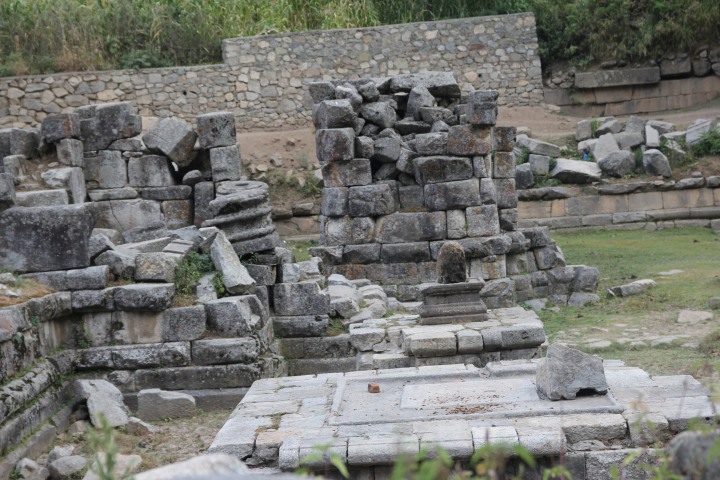
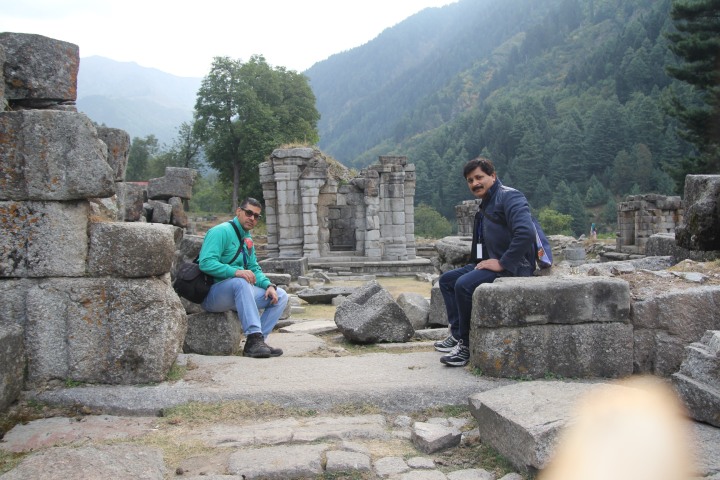

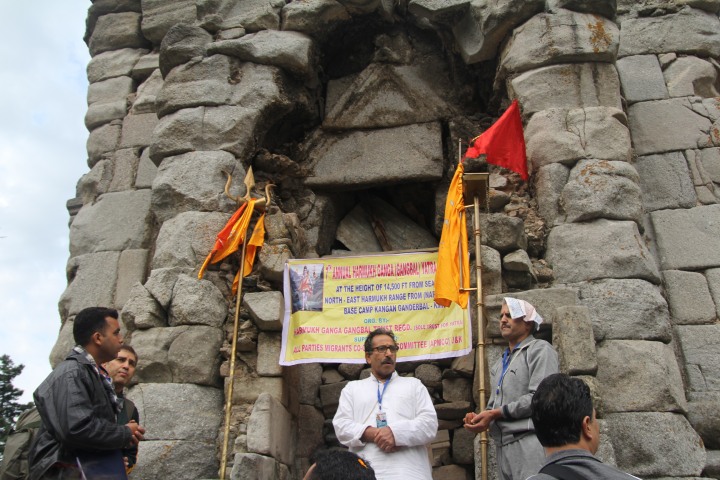
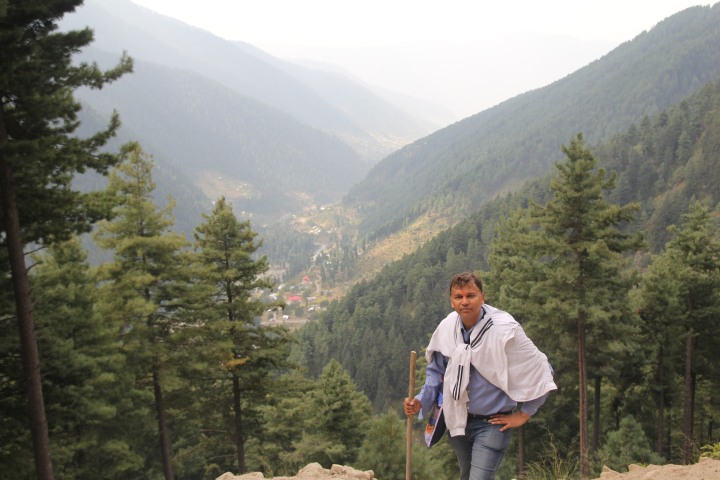
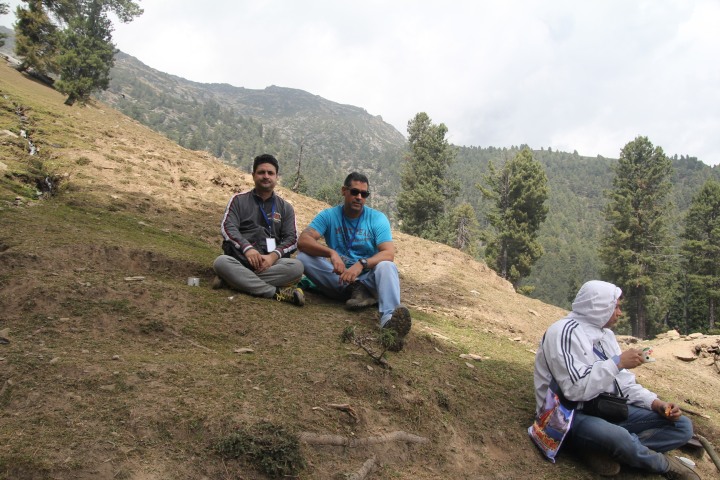

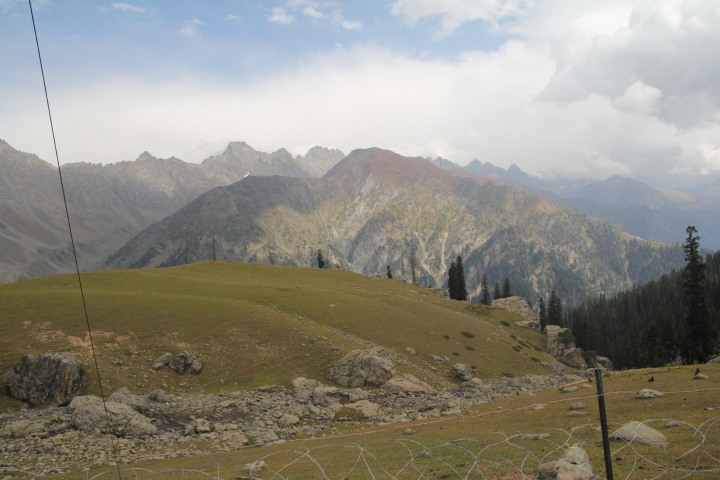
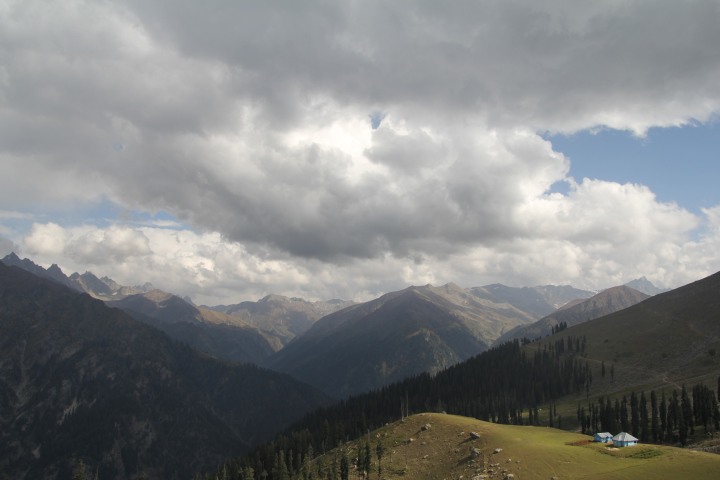

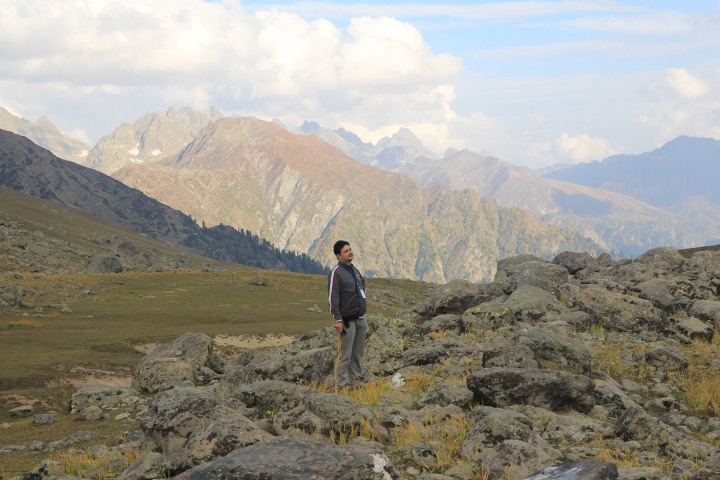
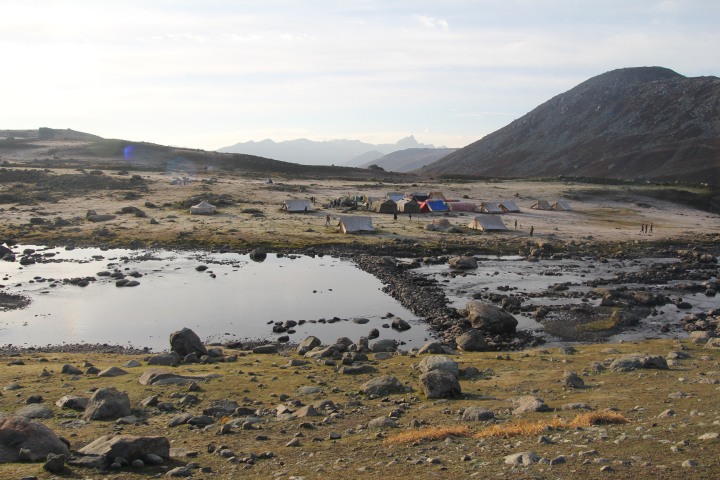
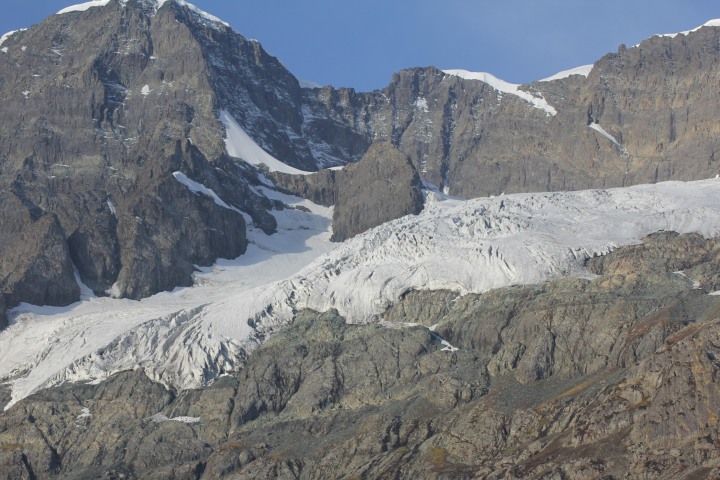
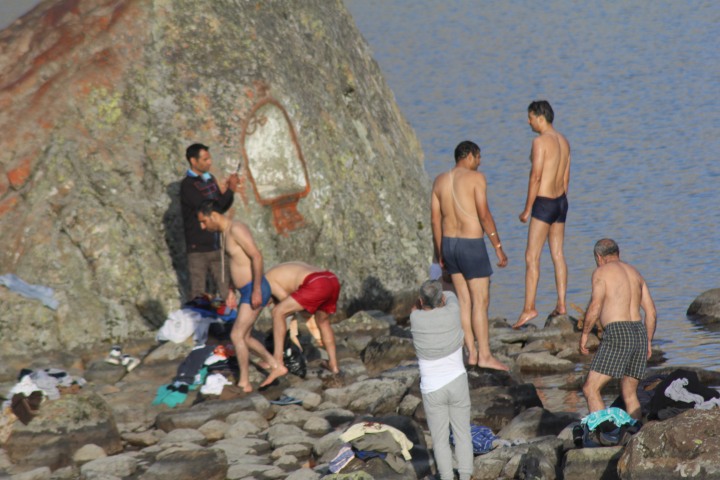

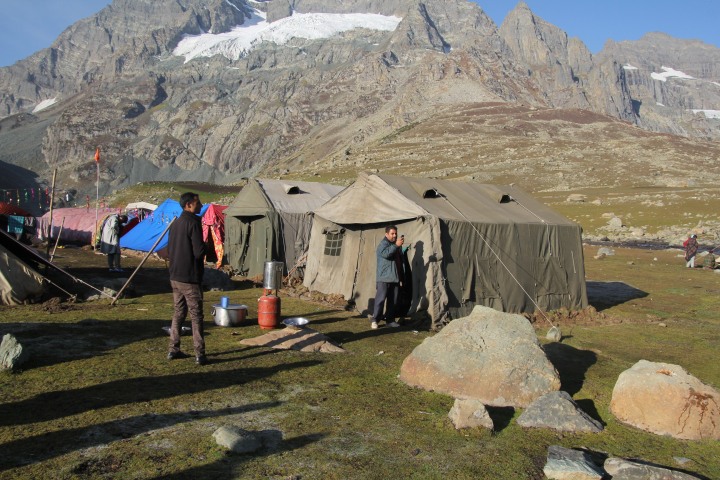

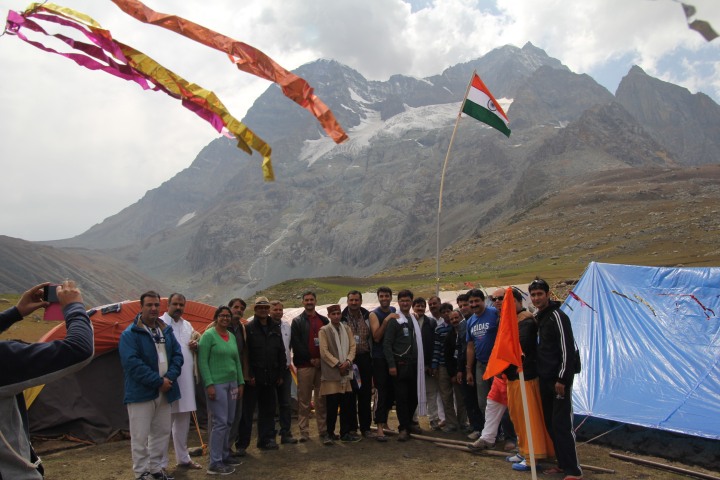

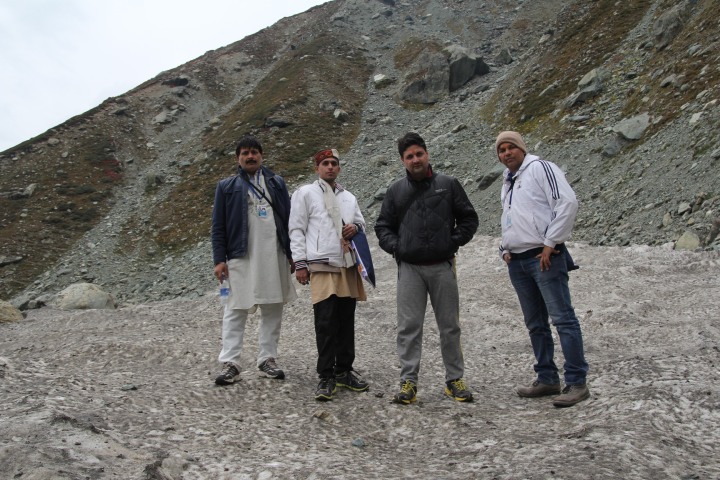

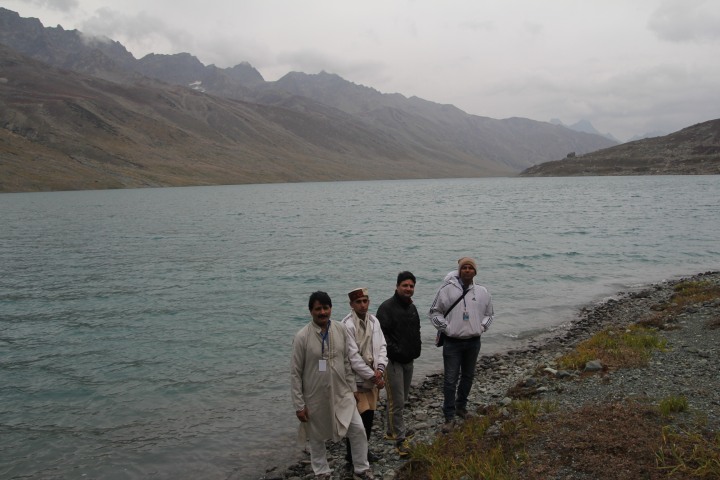

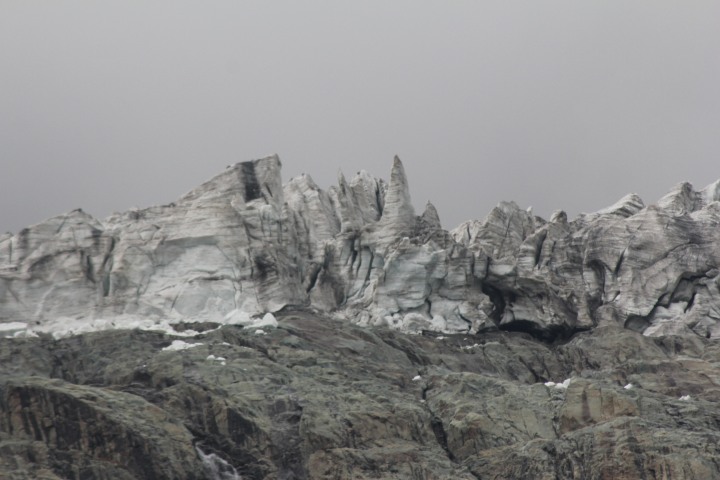
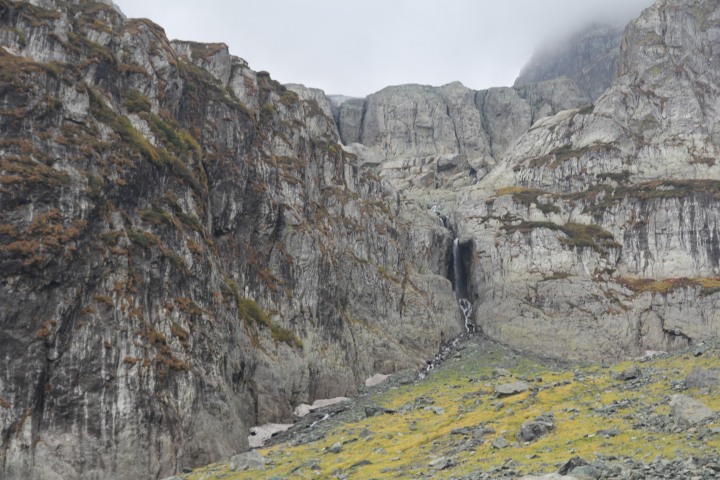


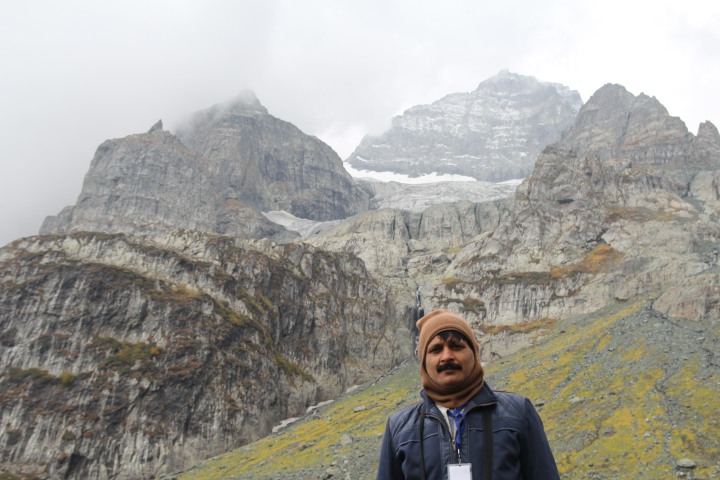

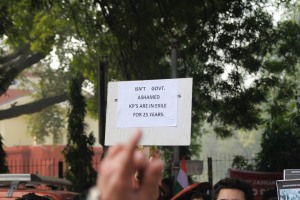
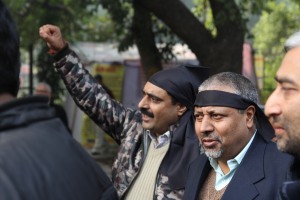
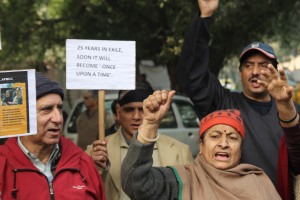
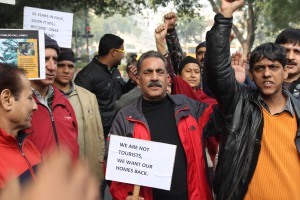

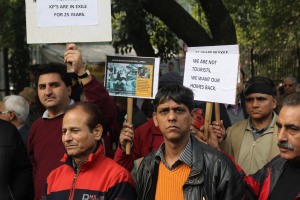
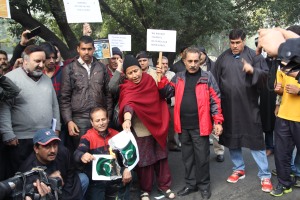
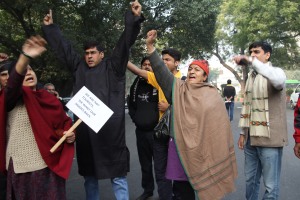
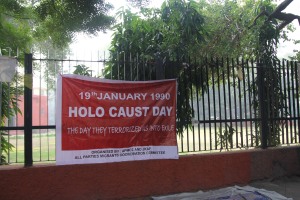
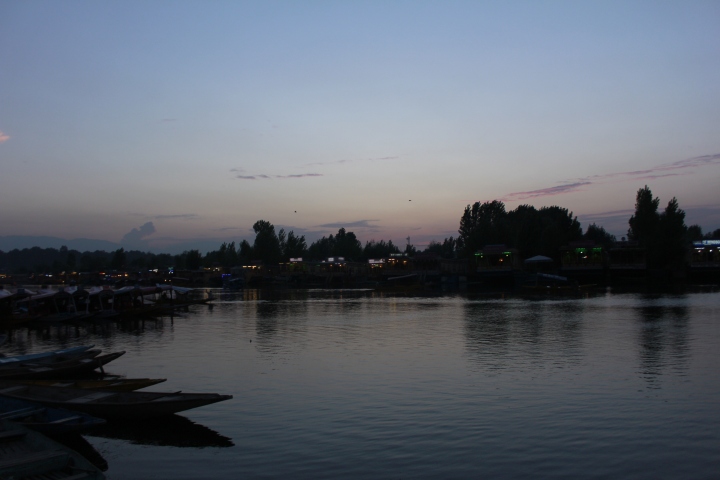
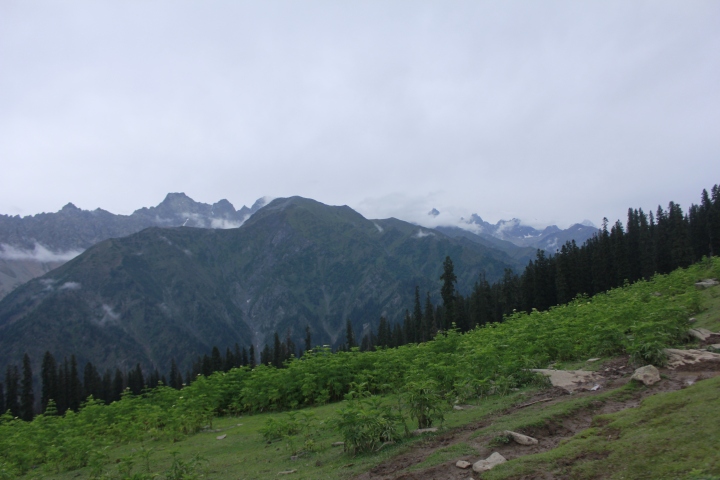

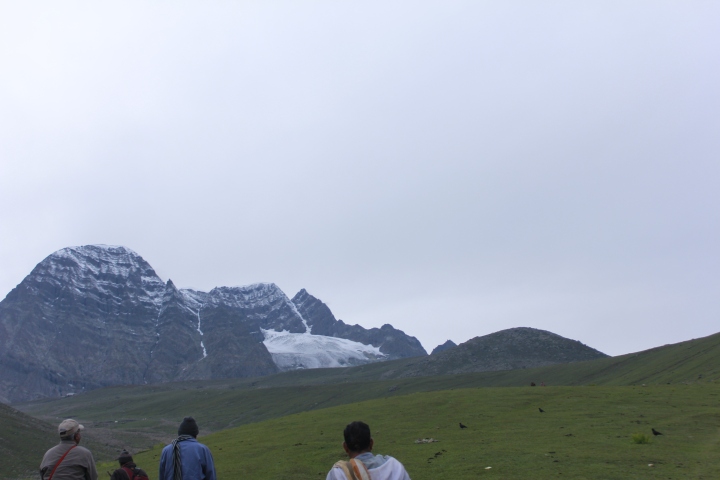



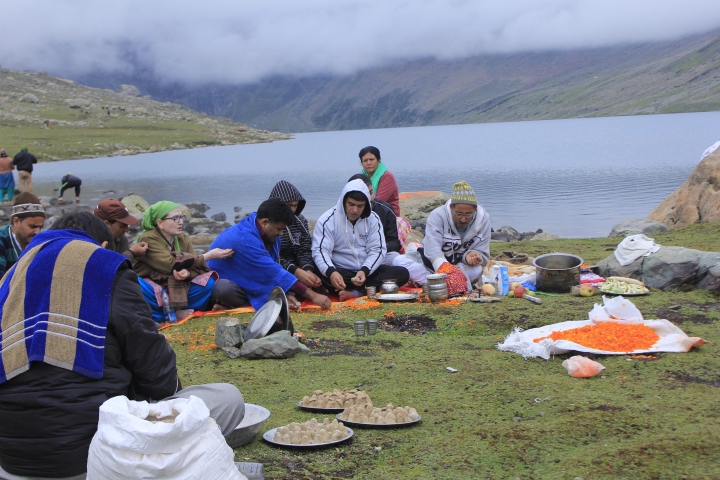
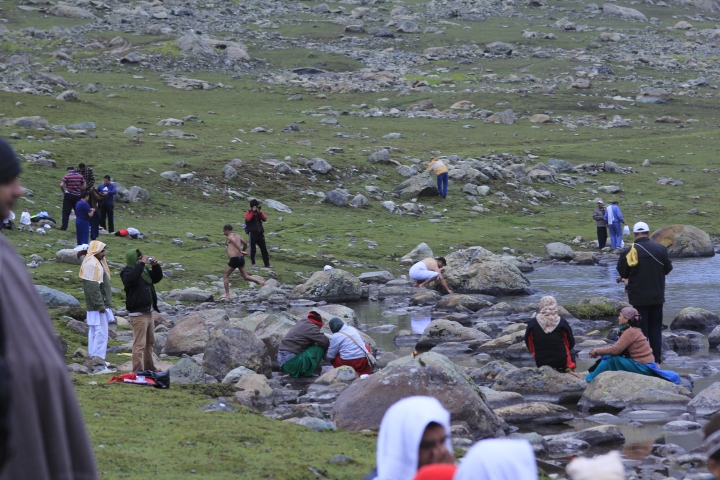
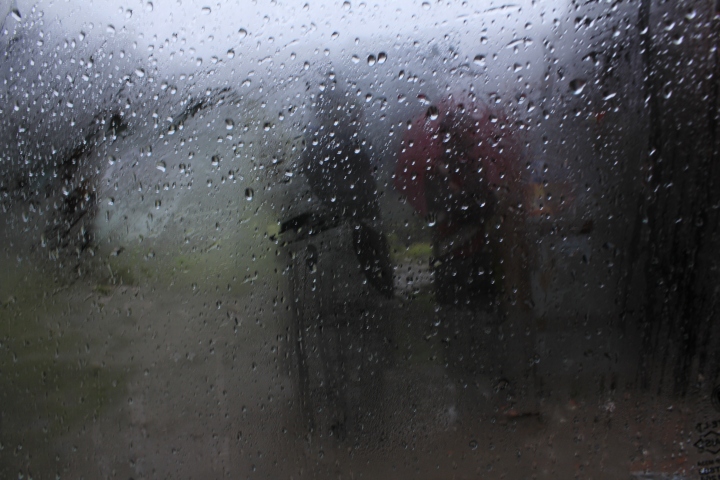
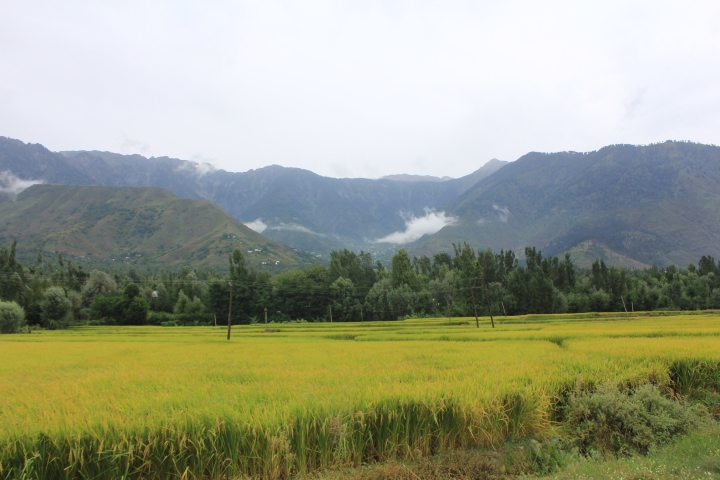








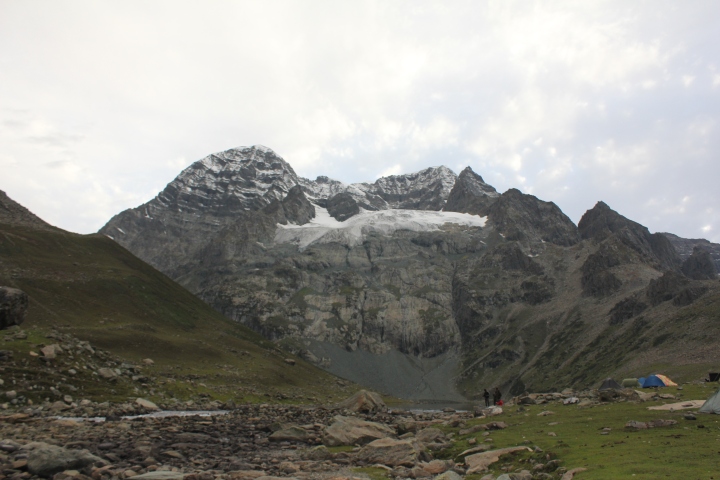

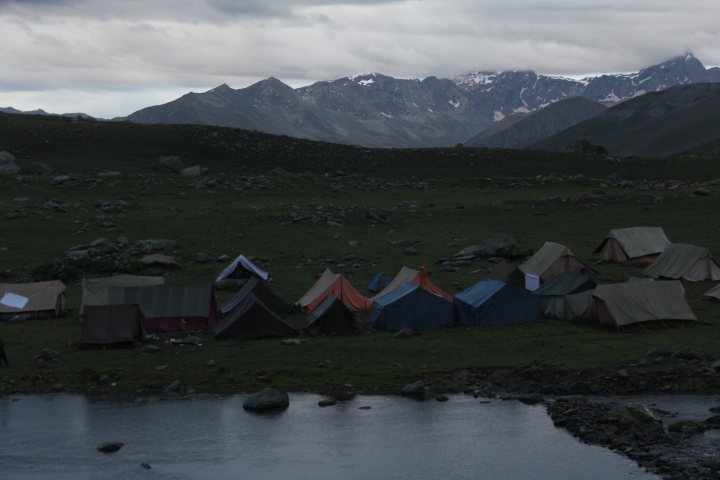
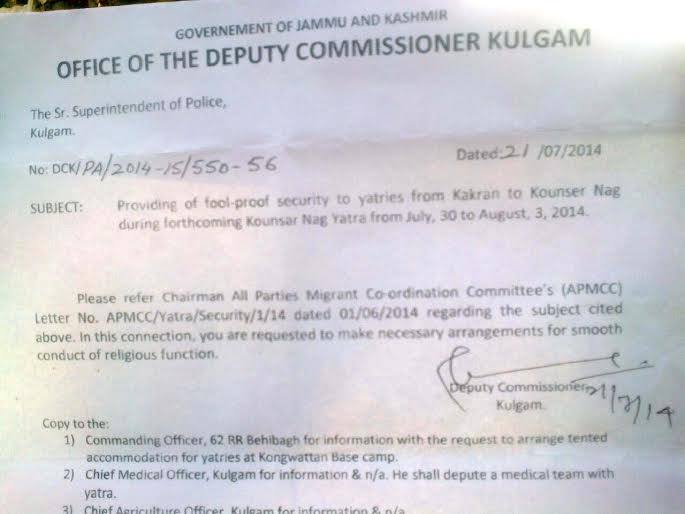





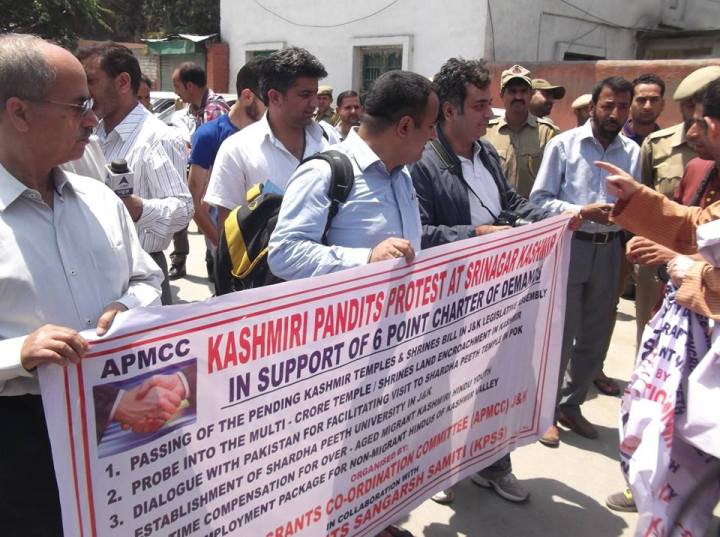

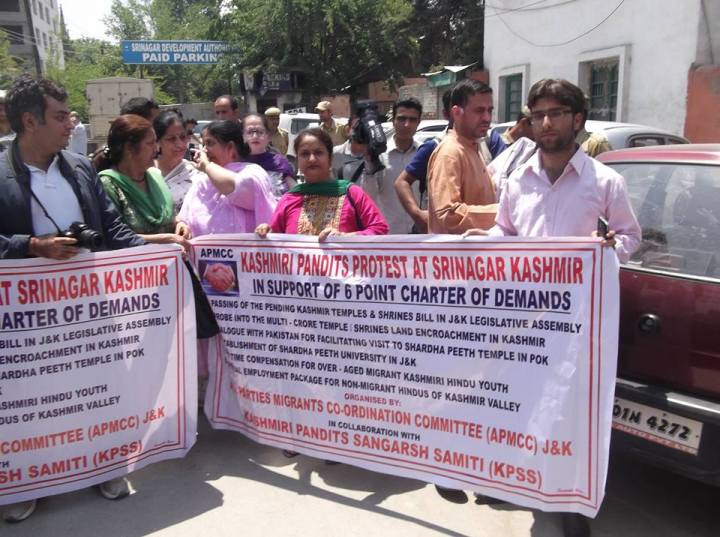
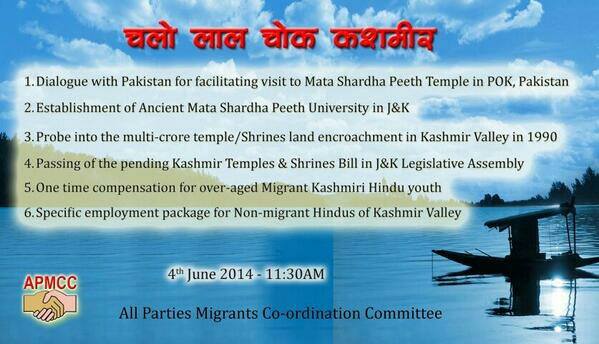










![Validate my RSS feed [Valid RSS]](valid-rss.png)
2 comments